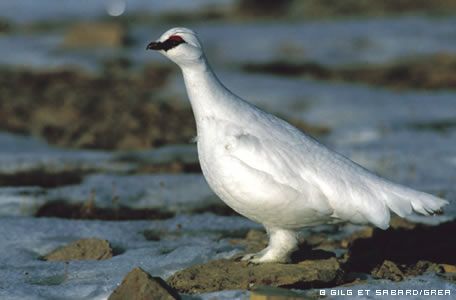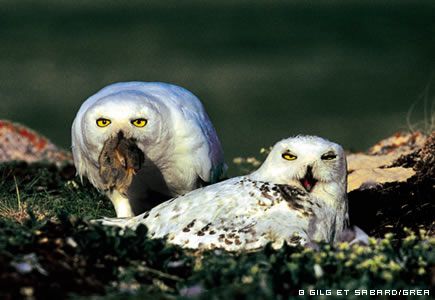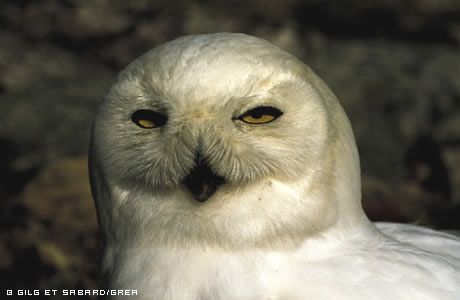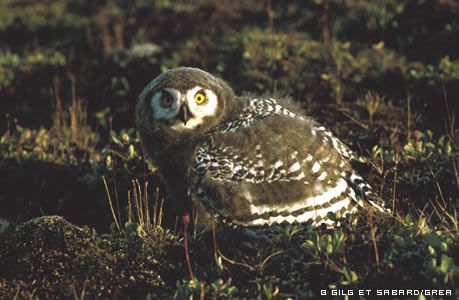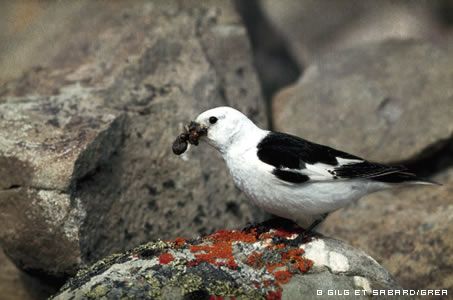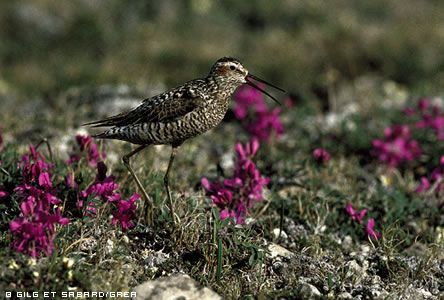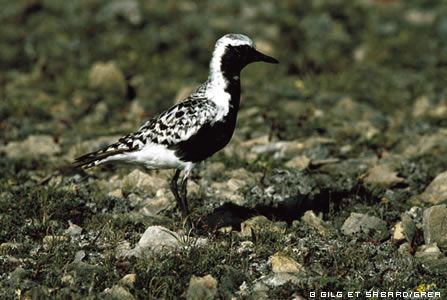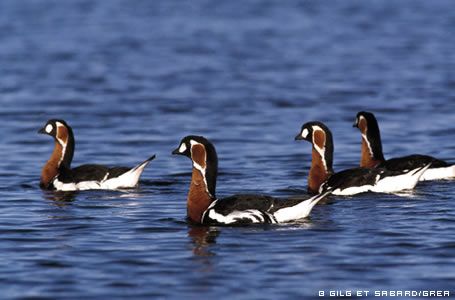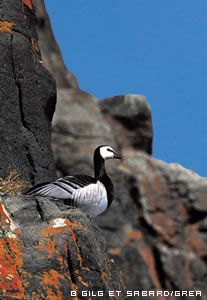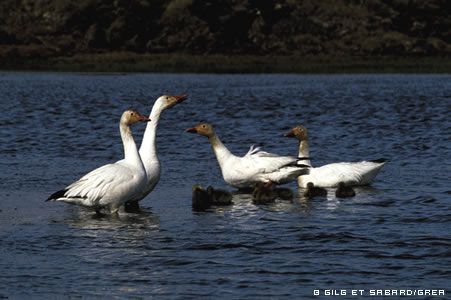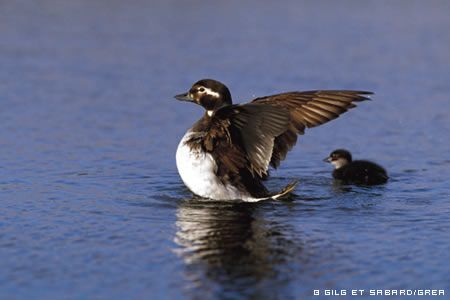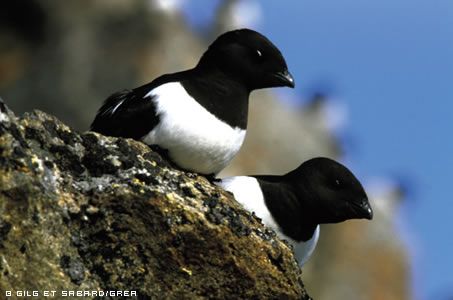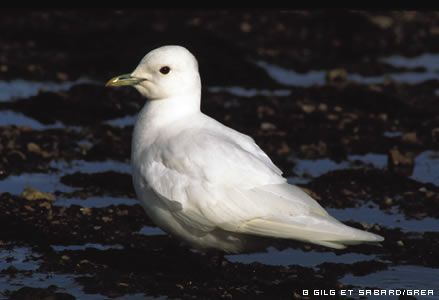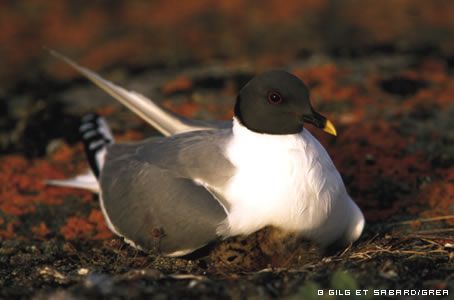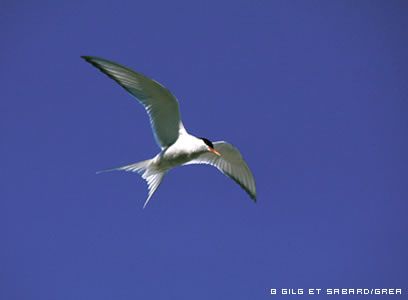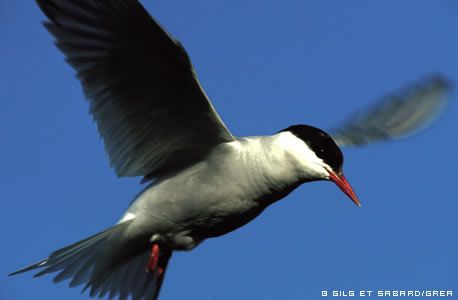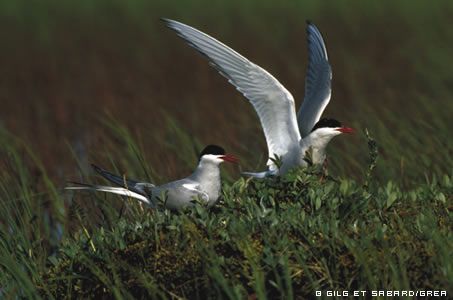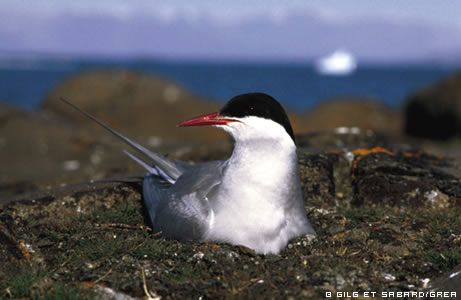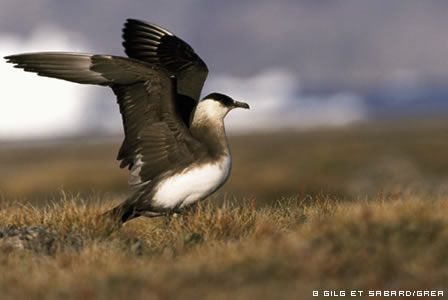Polar Encyclopædia
BIRDS OF THE ARCTIC
FROM THE SEA TO THE TUNDRA: A VARIETY OF HABITATS
Some 280 species of birds live in the Arctic regions, including land birds (grouse, buntings, snowy owls, falcons), sea or coastal birds (albatrosses, terns, gulls, guillemots, turnstones) and birds that prefer marshy habitats (snow geese, swans, ducks).
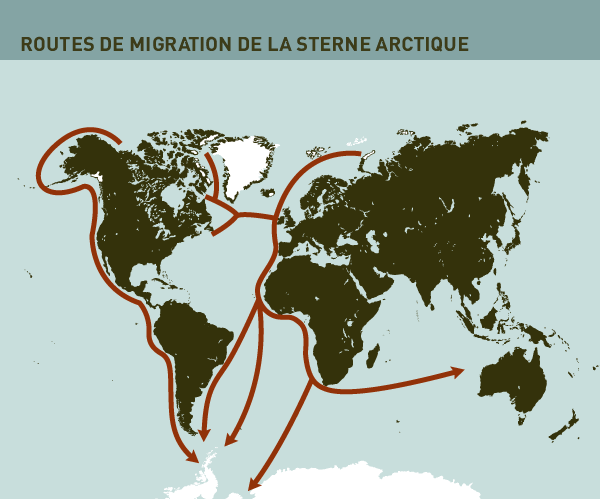
A MULTITUDE OF BIRDS DURING THE SHORT WINTER…
Once the warm weather arrives, huge colonies of seabirds nest on the coastal cliffs while others bring up their chicks in the tundra where there is abundant food for all tastes: fresh vegetation, clouds of insects, small mammals and other fauna filling the marshes and rivers. But the mother birds are never entirely at ease: even in mid-summer blizzards can still spring up and kill their whole brood.
…BUT ONLY A FEW HARDY BIRDS STAY FOR THE WINTER
Very few birds have the stamina to withstand the Arctic winter. In Canada for example, about 80 species of birds nest in summer but only 6 spend the winter in the Arctic. Those that winter there tend to have larger bodies and smaller extremities than birds that migrate to temperate zones. Snowy owls and grouse even have feathers on their feet. Their plumage is thick and white feathers for insulation and camouflage.
MOST BIRDS MIGRATE SOUTH
Multitudes of birds fly thousands of kilometres to escape the Arctic winter. Snow geese, ducks, gulls and guillemots prefer to spend the next few months on cliffs and lakes all across Europe while waiting for the “big freeze” up north to end.
A LAND BIRD PERFECTLY ADAPTED TO THE COLD: THE SNOWY OWL
The snowy owl seem perfectly at home in the rigorous Arctic climate and can be found anywhere between latitude 82°N (Ellesmere Island) and 55°N (the Bering islands) living between sea level and an altitude of 1,500 metres. The bird is all white, right down to the soles of its feet, and its plumage is one of the best examples (along with the fur coats of the Arctic fox and Dall’s sheep, or moufflon) of heat insulation in the animal kingdom.
In spring, the snowy owl flies even further north and mates where it finds an abundant supply of food. Whether in Siberia or Canada, Norway or Greenland, the first egg will be laid in each nest on about May 20. Owl chicks grow faster than any other bird of prey: young chicks have been known to double in weight over 24 hours but the average weight increase is 60-70% per day. The chicks can’t afford to hang around in the nest; the summer season is far too short!
Id card: snowy owl
| Name: Snowy or Harfang Owl (Nyctea scandica) |
| Length: 55-65 cm |
| Wingspan: 150-160 cm |
| Weight: 1.3-2.6 kg |
| Food: the snowy owl's favourite food is rodents, and lemmings make up 84-98% of its food intake. Owls have also been known to feed on grouse, hares fish and foxes. |
THE SEABIRDS MOST COMMONLY FOUND IN THE ARCTIC (BY FAMILY)
Procellaridae: fulmar, stormy petrel
Birds belonging to this family are pelagic (i.e. oceanic, living in the open sea) and have a slightly hooked beak with a gland located near the nostrils that acts like a filter, desalinating the seawater that they drink. They can stay at sea almost their whole life, only coming back to land to reproduce. They fly all day long, gliding on the air currents almost without flapping their wings at all, often very close to the surface of the sea.
These birds have a rather original defence mechanism: when attacked, they spit the salt that has accumulated in their nostrils, along with foul-smelling yellowish oil that is secreted by their stomach. This sticky mixture is usually enough to cause an attacker to desist.
Laridae: gulls
Adults gulls have white heads, bodies and tails, while the top of their wings is black or grey; young or immature birds have brown spots/markings. The most common species are the ivory gull, Sabine’s gull, the kittiwake and Ross’s gull.
Alcidae: razorbill, guillemot, auk, puffin
These are the Arctic equivalents of the penguins and diving petrels found in the Antarctic. They are excellent swimmers and spend a lot of their time at sea in flocks, but never venture very far from the coast. They dive for fish using their wings as flippers. Most of the time they nest on ledges or in cracks in a cliff face.
Skuas
Several species of skua are found in the Arctic: the Arctic skua, the pomarine skua, the long-tailed skua and the greater skua. They are all pirates, harassing other seabirds until they abandon their prey, which is then eaten by the skua.
Terns
Terns are sometimes called sea swallows, because of their shape (deeply forked tail and large pointed wings). The Arctic tern usually fishes quite close to the coast, but it also holds the migration distance record: terns fly from the North Pole to the South Pole and back, every year!
Cormorants
Cormorants have a rather heavy silhouette, with a long sinuous neck and large rounded wings. They usually fly very low and in V formation. When not swimming, cormorants perch on a rock and spread their wings to dry; unlike other seabirds, the cormorant’s plumage is permeable and they cannot fly when their feathers are wet.
Eiders: common eider, Steller’s eider
These are marine ducks that live along coastlines. They often form up into groups of 50 to 100 birds to fish together. Gulls often lie in wait for eiders to surface and then steal part of their catch. Sometimes, gulls can even be seen “protecting” their own group of eiders from other “pirate” gulls!
BIRD COLONIES: SAFETY IN NUMBERS
Nearly all (98%) seabirds live in colonies, taking turns to stand guard. That way individual birds have better protection against predators.
Some ornithologists think that this colony organisation also allows the birds to exchange information on where to find food, and that it stimulates individual birds (cries, songs, imitation of others’ activities).
In order to function properly, a colony must be in harmony with its environment, i.e. not too many birds for the available space. Only a limited number of nests can fit on a given cliff, and the same group of birds will return to nest there each year. Young birds learn their place in the group via contact with adults, gradually playing a greater role in the group’s social cohesion.
If the colony were to become too large, contact between individual birds would not be as efficient. Beyond a certain number, the group would disintegrate and chaos would ensue.
YOU HAVE TO DEFEND YOUR NEST
Seabird colonies are very noisy, because cries are an excellent way to communicate and cement cohesion. As the population increases, problems between neighbours may arise. There is not always enough room for all the birds, and this limits the number of couples that will be able to reproduce. This in turn means that couples need to defend their territory.
A loud cry is generally enough to discourage an intruder, but violent fights can break out between birds competing for the best nesting sites, and the fighting individuals sometimes take to the air and clash head on. When weather conditions are harsh (late snows in spring), these fights can even end in the death of a bird.
SEABIRDS FORM SOLID COUPLES
Seabirds begin reproducing quite late in their lives and usually mate year after year with the same partner and in the same nest. Seabirds invest a great deal of energy in reproduction and tend to limit the number of eggs per brood to three (compared with about ten for the passerine sparrow).
For example, the fulmar is faithful to its partner 80% of the time and to its nest 96% of the time. When one of the partners fails to return in spring it will mean that the bird has died or is taking a holiday (ornithologists call this a “sabbatical period”). Pairs of birds take several years to form a couple and the first attempts at reproduction usually take place in the ninth year.
FROM EGG TO CHICK
The eggs laid by most birds that live on cliffs, such as fulmars and guillemots, are pear-shaped, to prevent them rolling and falling off the rock ledge. The female fulmar, for example, lays a single egg, but a very large one (equivalent to 15% of the mother’s body weight). This represents an enormous investment of energy, and if the egg does not hatch or the chick dies, she will not be able to lay another during the same season. So the couple will do everything possible to ensure that the chick survives until it can “fly the nest”. The two birds take turns to incubate the egg, sitting on it for between 2 and 12 days for an incubation period of 40-60 days.
Gulls lay two eggs, but they are smaller and require less of an energy investment, so if necessary the female could lay again in the same season. Mostly, a seabird chick hatches covered with a fine down that protects it from the cold. But the adult birds still have to cover it until it gets its second layer of down. Only then can the chick survive without constant external input of warmth. Ornithologists call this “thermal emancipation”. From then on, the parents will take turns providing the chick with food. The adults go fishing at sea and bring back small crustaceans and fish for the chick, which at first can often eat its own weight in food in a single day.
LEARNING TO FLY
All young seabirds have to learn to fly to a very tight migration schedule: the day they must set off to fly southwards varies according to the species and the distance to be covered. Often, the chick’s parents will incite it to try its wings by withholding food, so that hunger will drive the bird to jump off the cliff to fish for itself. Some members of the alcidae family take their chicks out to sea fishing even before their first growth period is completed.
BIOLOGIST’S AND NATURALIST’S CORNER
Surviving foxes, rats and men
Numerous species of birds nest on the islands in the Bering Strait, where the waters provide an abundant supply of food. Until they were discovered by the sailor Vitrus Bering in 1741, these islands were an ideal nesting site because there were no predators to attack the birds. Unfortunately, Man introduced the fox to exploit it for its fur. The fur business peaked between 1900 and 1930, by which time the foxes had ravaged the seabird population. In 1949, the Americans launched a drive to eradiate the foxes and today the seabird population has tripled. But seabirds still have another predator — the rats that came ashore from various ships – and a variety of means (rat patrols, port fences, traps, poisoned baits) are being used to keep their numbers down and safeguard the seabirds.
How do seabirds navigate during their migration ?
Every year, thousands of birds take the same migration routes along the Atlantic and Pacific coasts. Ornithologists think that they navigate by the sun and the stars, perhaps also using memories of the coastal outlines, and that they can follow the lines of the Earth’s magnetic field (geomagnetism).
Birds from the Arctic, in our own gardens
Whether you live in the tropics, in European cities or up in the Alps, during the spring and autumn you can observe birds that will be nesting in the Arctic in the boreal summer. Many regions in Europe and the Americas are on their migration routes. All you need to do is choose a likely lake or marsh, find a pair of binoculars, and sit down to wait… And if you need, help, there’s probably a local birdwatcher’s club nearby.
JEAN-LOUIS ETIENNE AND THE BIRDS OF THE ARCTIC
“I had hardly taken a few steps when a brown bird flew straight at me, brushing me with its wings as it flew past, screeching loudly. I immediately understood that I was intruding on its territory. (…) I recognised it as a pomarine skua. (…) It hovered over my head and I could feel the downdraft from its wings getting closer, giving me gooseflesh. The survival of the species can inspire individual creatures to all sorts of bravura… Suddenly, about ten metres away, I saw another skua on the ground. This one was hobbling clumsily among the rocks, one wing sticking crookedly up in the air, and it was uttering sad cries of pain. This was clearly the female, trying to create diversion so that I would change direction. Then I saw it: straight ahead of me was her brown egg, just a few steps away, lying on the ground, with no more than a few twigs as a nest”.
Jean-Louis Etienne, “La complainte de l’ours”, J-C Lattès, 2001.
DID YOU KNOW ?
> The huge colonies of seabirds that nest on coastal cliffs in the Arctic regions help the flora to grow, by adding large quantities of fertilizer (their droppings…) to the soil.
> Puffins nest at ground level on grassy islands, sometimes digging their own burrows and sometimes using rabbit burrows (after driving the occupants off…).
> The average life expectancy of a seabird (depending on the species) ranges from 8 to 40 years (8 for the kittiwake and 40 for the albatross). Seabirds of equivalent weight live longer than terrestrial birds. For example, the stormy petrel (only 20 cm) has an average lifespan of 20 years compared with 2 years for the tit you see in your garden.
> There are 15 species of geese in the world, and 12 of them nest in the Arctic.
> The eider, a sort of marine duck, has very thick downy plumage, which gave its name to the eider-down bed covering that our grandparents slept under.
> Inuit children liked to hunt birds. Between May and September, when little auks were nesting, Inuit children used to hunt the birds in the cliffs using a little net to scoop them out of the air. In eight hours, a good hunter could catch up to 500 of the birds. Eskimos would also take eggs and chicks, which provided them with substantial protein intake.
TO FIND OUT MORE …
BIBLIOGRAPHY
- Faune et flore du Grand Nord – GNGL 1999
- La chouette Harfang (R. Sané, Bulletin GREA-CEMDP n°1-1996)
- Actic Flora and Fauna – status and conservation – CAFF 2000
- Satellites Track King Eiders (L.Dickson, WWF, Arctic Bulletin, n°1, 1999)
- Too many snow geese, a conservation problem ? ( B. Ganter, WWF, Arctic Bulletin, n°1, 1999)
- Global Overview of the Arctic Breeding Birds (G.Boere, WWF Arctic Bulletin, n°2, 2000)
- Intercontinental Flyways of Arctic Water birds (WWF, Arctic bulletin n°2, 2000)
USEFUL WEB SITE
- In french :
http://www.lpo.fr/ - In english :
http://www.birdlife.org/
Support the project with a donation
The Polar POD expedition is one of the stamp of the pioners, a human adventure coupled with a technological challenge, an oceanographic exploration never before carried out which will mark a milestone in the discovery of the oceans.
Thank you for your support !
